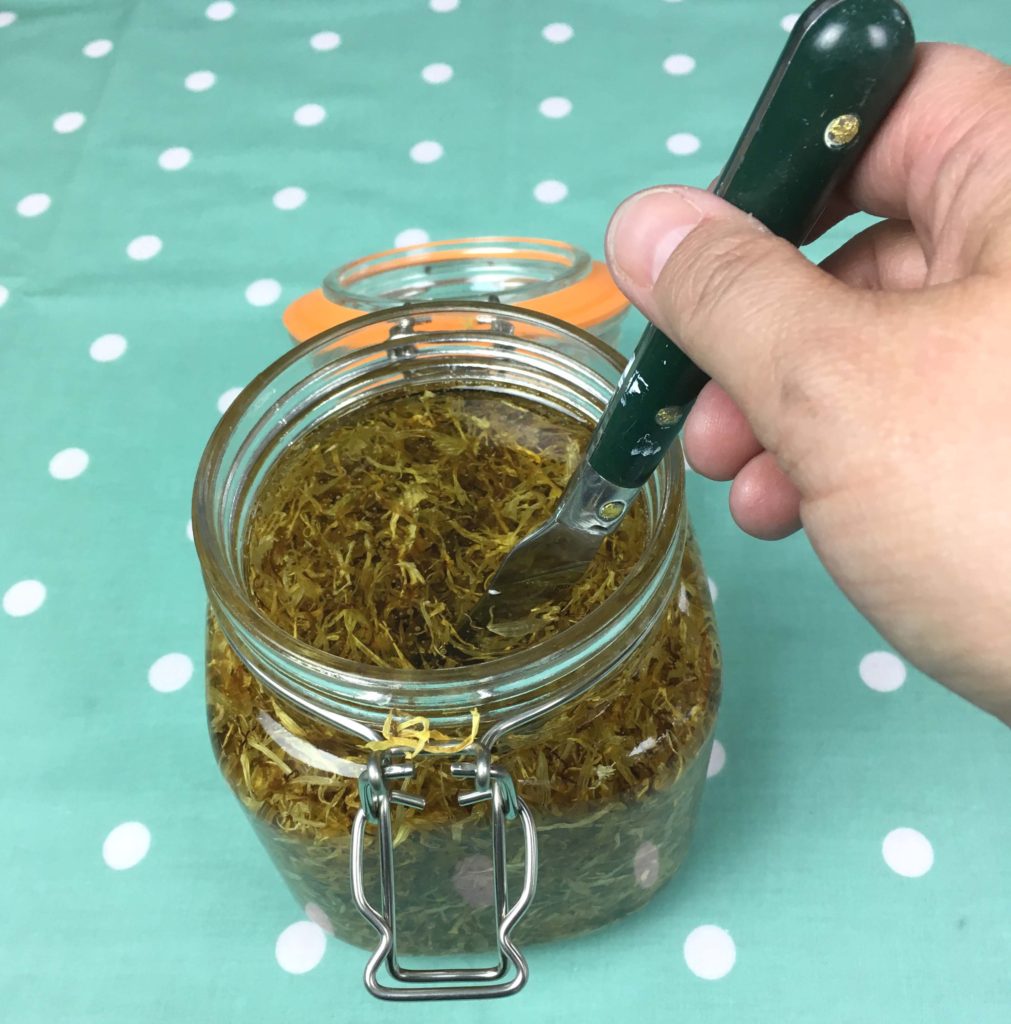Calendula has a reputation for being one of the best plants to use for our skin. An infusion of calendula flowers has long been traditionally used as antifungal and antiseptic in wounds, marks, freckles, sprain and even conjunctivitis.
Calendula tea has been used as an eyewash, gargle, for nappy nappy rashes and other inflammatory conditions of the skin.
Calendula officinalis (Pot Marigold) preparations are used in complementary and alternative medicine systems mainly for burns, cuts, rashes, dermatitis, dry skin, bee stings and foot ulcers.
To get access to the useful compounds found in Calendula flowers, we need to extract them. You can infuse them in water to make a calendula tea, you can make an alcohol tincture, or you can infuse them in oil. I’m going to infuse my calendula petals in oil as I plan to use them to make soap. You could also use a calendula tea to make soap.
It is very important that you use dried calendula petals for this as we don’t want to introduce water into the oils at all. If you want to use calendula from your own garden, you can of course, but you should let it dry first. Just cut the plants, tie them upside down and hang them somewhere out of the way for a week or so. An airing cupboard would be ideal for this or another dry place (not a bathroom!) I’ve moved house recently so I haven’t got any in the garden. I’m using dried calendula that I bought from a soap making supplier.
Next, you’ll need to think about the oil you wish to use. I’m going to use my infused oil in soap so I’ve chosen olive oil. If you are planning to use yours in a balm or body butter, I would suggest something a bit lighter such as grapeseed oil or almond oil.

So here is my big jar of calendula petals. I’ve also got a smaller jar to make the oil infusion in. The smaller jar holds 1 Litre of oil. I love this light coloured olive oil for my soap.

I’ve filled my jar a bit over halfway with calendula petals. I wanted to get loads of petals in there but I still wanted to leave plenty of room for the oil and also to be able to move the petals around occasionally.

I filled the jar up with oil leaving a small space at the top for any expansion of the oils and calendula petals. The jar took all 1litre of the olive oil.

I gave it a good stir with the implement closest to me at the time! This is to make sure the oils mix with the calendula petals and no petals are left in clumps. We want the oil to surround each petal and all the useful compounds in the petals to be free to move out into the oil.
The oils can then be put on the windowsill to solar infuse for about 6 weeks. The heat of the sun coming through the window will slowly and gently heat the oils and infuse them. If you are concerned (rightly so) about leaving oils in the full sunlight like this, you can cover them with a paper bag to stop the oxidising effect of the sun. Give them a shake every now and again to keep them surrounded by oils.
SIX WEEKS! I hear you cry! There is a way to speed this process up?
Why yes there is! Once the jar is ready as described, you can pop it into a slow cooker (crock pot) with some warm water. Keep it on the low setting and place the jar inside. You can leave it to infuse in the warm water with the lid slightly open for about 8 hours. Be careful when you remove it because it will be warm. You could turn the slow cooker off and leave it to cool before removing it if you like.
When your oils have finished infusing, you’ll need to strain them using a piece of muslin. You could also use a sieve lined with a coffee filter. Put the strained oils into another container and you’re good to go.
Your infusion is now ready for your chosen recipe. Keep an eye out for later posts where we’ll use our lovely infused oil.
If you’d like to join our email list, you can sign up in the sidebar or by clicking HERE.
Joining the email list will give you exclusive access to our Resource Library for FREE. You’ll find recipes, downloadable guides and loads of information about soap and body products.


